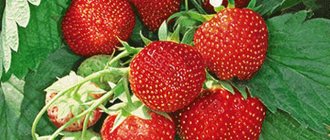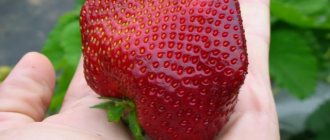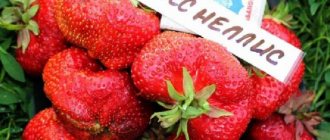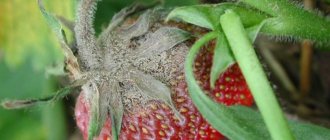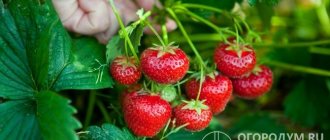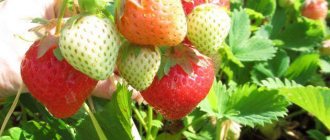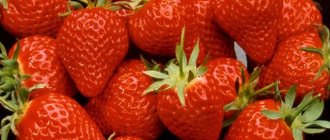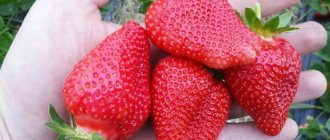Description of the variety and photo
Tristar is popular among chefs. The plant has good taste and attractive appearance. The main regions of cultivation of the variety are Europe, South and North America and Australia. Strawberries are not very picky to care for. The optimal soil for growing it is loamy soil. The bushes are of medium height. Their diameter reaches 75 cm. Up to 10 mustaches can form on one bush.
Important. The variety tolerates low temperatures well and has the ability to self-pollinate.
The most abundant harvest is harvested in the spring. In autumn, the plant's berries reach their maximum size. The second harvest begins to form in August. Ripening in open ground continues until the first frost.
Among the advantages:
- disease resistance;
- possibility of growing indoors;
- high yield.
In the first year, it is recommended to remove flower stalks. This is done to strengthen the plant and better adapt it to the soil and climatic growing conditions. Tolerates cool climates well. Productivity is maintained for 3-4 years after planting.
Reviews from gardeners
Strawberries of the "Renaissance" variety are highly revered by gardeners in our country as one of the most unpretentious berry crops with good frost resistance and high resistance to diseases and pests.
According to reviews from gardeners, the “Tago” variety is distinguished not only by the excellent taste of ripe berries, but is also characterized by consistently high yields in home gardening conditions. The berries are very large, bright red, with well-colored dark and sweet pulp. Therefore, they make very beautiful and tasty types of jam, as well as compotes.
No less interesting for home gardening is the American variety “Tristar”, the berries of which have proven themselves to be excellent when frozen. Growing this very productive variety requires annual replanting of bushes. After harvesting the first harvest, it is necessary to clean the bushes, which consists of removing old leaves, and to fertilize, water and loosen the soil on the berry plantings.
Characteristics of the berry
The fruits have an elongated conical shape. Their size depends on various factors. The average weight of the berries is 28-30 g. Their calorie content is 36.9 kcal per 100 g. They have juicy pulp, a pleasant aroma and dietary taste. The berries are bright red.
Important. Can be used to treat colds and eliminate bad breath.
The berries have antimicrobial and anti-inflammatory properties. They contain carbohydrates. They practically do not increase carbohydrates in the blood, so berries are allowed to be included in the diet of patients with diabetes.
The weight and ripening of berries depends on:
- proper plant care and feeding;
- climatic conditions;
- fruiting period.
Strawberries contain iodine. The salicylic acid it contains plays an important role in joint health.
Reproduction
You can propagate using seeds and tendrils. The main method of propagation is seedlings. It is grown using seeds. Their germination occurs in several stages. First, the seeds are placed between two paper napkins and sprinkled with water from a spray bottle, after which they are placed in a plastic bag. In this state, the seeds swell for 2-3 days at room temperature. Moisturizing is carried out during this period every day.
The following stages of preparation:
- Maintain for 14 days at a temperature of +4°C.
- Germination takes 2-3 weeks at a temperature of +18-22°C.
- Transferring seeds to peat soil.
Important. Seeds with shoots of at least 1 cm are transferred to the prepared soil.
When germinating seeds in autumn or winter, additional lighting is provided for them. Use fluorescent lamps. If seedlings are planted in containers, then the volume of containers is taken at the rate of 2-3 liters per 1 bush. In closed ground, bushes are replaced after 2 years of fruiting. Before planting seedlings, warm the soil. When planting seedlings in open ground, it is filled with water at a temperature not lower than +60°C. Potassium permanganate is added to water for irrigation.
Sowing seeds can be done at any time of the year. When grown in open ground, sowing is done in late January or early March. The soil for seedlings is prepared from 3 parts sand and 5 parts humus. To warm the soil at home, you can use an oven. The soil prepared for planting is placed in it for 3-4 hours and kept at a temperature of 90-100°C.
When propagated by whiskers, they are buried in the ground. After the root system has developed well, the mustaches are transplanted to the beds prepared for them.
Landing
The bushes are planted in beds 90-100 cm wide. The optimal distance between plants is 60-80 cm. The planting site is changed every 2 years. To plant seedlings in containers, use a mixture of neutralized peat, vermicompost and manure humus. In stores for gardeners and gardeners you can find specially prepared substrates.
Important. Seedlings are planted in open ground after the appearance of 5 full leaves after the first picking.
Dutch technology is excellent for growing Tristar indoors. Plants can be placed on it in horizontal and vertical beds. The choice of method depends on the technical capabilities of gardeners.
Year-round harvesting in closed ground depends on:
- time of planting seedlings;
- illumination of beds;
- watering and fertilizing the plant.
Important. The time interval between planting new seedlings should be 2 months. Normal growth occurs when the daylight hours are 15-18 hours. To do this, lamps with a power of 50-60 W are installed in greenhouses, 1 piece per 6 sq.m. The humidity in the room for growing Tristar should be at least 72%. The optimal temperature is +18-21°C, during the flowering period +28°C.
Open ground for mother bushes begins to be prepared in October. The following are added to the soil:
- organic fertilizers;
- lime;
- potassium chloride;
- superphosphate.
Tristar bushes do not produce side shoots. This greatly simplifies the care process.
Watering
"Tristar" is a moisture-loving variety. Regular watering is necessary from early May to September. The best method is drip irrigation. Strawberries should receive sufficient moisture, but water stagnation should not be allowed. The first watering of those grown in open ground is carried out before the first shoots emerge to warm the ground.
Each type of soil must have its own moisture content:
- sandy - 65-70% during growth, 60-65% after harvesting;
- heavy soil - 80%;
- chernozem - 70-75%.
The average water consumption when irrigating light soils is 80-100 cubic meters per 1 hectare. On loams it increases to 120 cubic meters per 1 hectare. In dry spring, watering of plants begins at the end of April. In cold summers, water no more than 3 times a month.
Important. During the growing season, plantings are watered at least once a week.
On hot days the amount increases 2-3 times. It is especially important to strengthen on sandy soils. In autumn, high humidity poses a serious danger to strawberries. It leads to rotting of the root system. In damp soil, pathogenic microorganisms and bacteria actively develop, leading to the death of the plant. In dry autumn, the beds are watered once a week.
Care and feeding
Includes a set of activities. Among the main works:
- Removing weeds and dry leaves from the beds. Work is carried out as needed throughout the growing season.
- Loosening the soil. It is especially important to do this after heavy watering and rain.
- Hilling. Work is carried out as needed, but at least once a month.
- Feeding. For each stage of growth, a different fertilizer is used.
- Mulching the soil. Filling the rows with mulch significantly reduces the number of weeds.
Important. Agrofibre can be used as a mulching material. Feeding is carried out according to a certain scheme. The composition depends on the time of year and stage of growth.
The main feeding of strawberries is done in early spring. Complex mineral fertilizers are applied to the soil. They contain nitroammophoska. It is diluted with water at the rate of 1 tablespoon of the substance per 10 liters of water. During this period, mullein or bird droppings diluted with water in a ratio of 1:10 are used as organic fertilizer. Solutions are applied at the root, 0.5 liters each.
At the stage of bud formation and berry set. To increase productivity, bushes are sprayed with boric acid at the rate of 1/2 teaspoon per 10 liters of water. Potassium nitrate, wood ash or an infusion of bird droppings are added to the soil.
At the stage of preparation for winter. Nitroammophoska diluted in 10 liters of water is added to the soil in the amount of 2-2.5 tablespoons or 1 glass of wood ash.
To dilute fertilizers, only warm water is used. To increase productivity, excess whiskers are removed. After 3-4 years of cultivation, the beds are moved to a new location.
How to plant strawberries (video)
Many gardeners grow Tristar as a balcony or hanging crop, as well as on vertical beds. In the case of growing on ridges, experienced gardeners recommend not cutting off the mustache, but distributing it evenly along the ridge. As a result of such an event, it is possible to easily replace all the mother plants with younger bushes of garden strawberries.
We are attracted to Tristar strawberries because they can be grown not only in open ground, but also on the balcony. Winter cold and frost can be tolerated without problems; you just need to cover the beds after harvesting. We usually plant them in the spring and they take root well. Although there are not very many tendrils, there are no more than a dozen of them on each bush, but they are quite enough for us; we grow them only for the needs of our own family. Maintenance is simple, all you need to do is remove weeds on time, loosen the beds, mulch them, water them as needed, periodically feed them; we usually water them with mullein solution. And remove dry leaves all the time. But all this does not take a lot of time and effort. Tasty and juicy fruits delight us all, and especially children, until late autumn. The little ones are happy to eat strawberries immediately after picking; they don’t even need sugar, just sprinkle them with sour cream. We consume the bulk of the berries fresh, and partially freeze what remains. But more often we make jam, because large and dense berries look very beautiful on the table, and the taste is pleasant. We don’t make compotes for the winter; we make them only in the summer, for immediate consumption.
I found a variety of strawberries that contains a minimum of carbohydrates and does not increase their level in the blood at all. As someone on a low-carb diet, this was very suitable for me, but I know that it can also be eaten by people with high sugar levels. I grew seedlings from seeds at home. First, I kept them in the refrigerator for 2 weeks (hardening off to increase frost resistance and disease resistance), then I germinated them, and then planted them in well-fertilized soil. Tristar can grow in the same place for 2 years, then it must be transplanted to another. The bush itself produces a harvest for 4 years in a row. Gives 2 harvests over the summer: in early June (the most voluminous and in August (the largest berries). The bushes are tall, some are higher than half a meter, but with a moderate number of leaves. They form mustaches, on average 5-10 from each bush. If you plant seedlings in the spring, then the soil must be prepared in the fall. I added superphosphate and organic matter, and also potassium chloride. In the first year, I cut off the flower stalks to allow the strawberries to take root. I water all summer, more intensely in the heat. Tristar is able to withstand frosts. I really like the taste of strawberries , despite the small amount of sugars, it is not sour, but slightly sour.The berries are juicy and aromatic.
This is one of the few varieties that grows well in our loamy soils. But before planting, we added humus to the soil in sufficient quantities - we bought seedlings in a nursery near Vologda, and we didn’t want to lose them due to illiterate care. The bushes are spreading, planted at a distance of 40 cm and left 50 cm between rows. Although the agronomist recommended removing the first flower stalks, we only partially removed them - we wanted to try the berries of a new variety. During the first fruiting, the berries are not the largest, they weigh 20-25 grams. Autumn ones are larger, up to 50 grams. The pulp is very juicy, but if you don’t water it enough, it will be a bit dry. We need to ensure that the soil does not dry out; we water the area a couple of times a week. This variety produces few side shoots and care is not difficult. But after each watering, it is advisable to loosen the soil and mulch. We use hay for mulch. From fertilizers, we add nitroammophoska in the spring before flowering (1 tablespoon per bucket of water) and bird droppings in the fall, half a liter of solution for each plant. Bushes of this variety overwinter safely, we only cover them with fallen leaves from the trees, that’s enough.
Diseases and pests
Strawberry "Tristar" has good resistance to various diseases, but this does not exclude the possibility of being affected by them. Existing diseases can be divided into 3 large groups:
- Fungal (anthracnose; white, gray and black rot; rhizoctonia; white, brown, brown and red spots; powdery mildew; gray mold; phthitophorosis of roots, etc.)
- Bacterial (leaf scorch, root cancer, mottling and wrinkling viruses).
- Mycoplasma (greening of petals, devil's broom).
Various drugs are used to combat strawberry diseases. Many diseases are the result of improper care.
Important. To combat, you can use solutions of iodine and potassium permanganate.
Among the most dangerous strawberry pests are garden mites and spiders, aphids, wasps and birds.
Advantages and disadvantages of the variety
Tristan strawberries are valued by summer residents for their good yield. This is a great option for lovers of fresh strawberries throughout the summer season and even early fall. The variety also has other tangible advantages.
Strawberry Tristan produces a harvest for four months
Pros:
- high, stable yield;
- long fruiting until the first frost;
- pleasant taste and aroma;
- attractive presentation;
- low maintenance requirements;
- good keeping quality and transportability;
- resistance to some diseases.
Minuses:
- high cost of seed material;
- plants cannot be spread with tendrils;
- The culture does not take root in all regions.
Strawberry "Tristan": description of the variety and features of agricultural technology
Strawberry "Tristan", the description and photo of which are given in this article, is an exotic hybrid variety of garden strawberry, classified as decorative. Rosettes of "Tristana" stand out from the general mass of strawberry bushes with large, bright pink flowers, and therefore they are often used to decorate garden plots, summer terraces and balconies. But this unusual variety is famous not only for its beauty. Judging by reviews from gardeners, Tristan berries are distinguished by their particularly sweet taste and subtle aroma.
Description and specific features of the variety
"Tristan" bushes are densely leafy, lush, but compact. The average height of the rosettes is 25 cm.
“Tristan” is a remontant late-ripening hybrid, so flowering and fruiting of plants of this variety continues from mid-June until the beginning of the first autumn frosts.
"Tristan" - a decorative variety of garden strawberries
Rosettes of "Tristana" become especially beautiful during the period of mass bud blooming, but even after the first wave of flowering subsides, the bushes strewn with ripening berries look very elegant. The flowers of this hybrid are truly magnificent - large, deep pink and very fragrant.
Another advantage of this variety is its high disease resistance. "Tristan" has genetically fixed resistance to most viruses and fungi that infect berry crops of the Rosaceae family.
Advice. Due to the fact that the Tristan bushes do not form tendrils, the seedlings of this hybrid can be planted more densely than the rosettes of other traditional strawberry varieties.
During the growing season, the bushes of most varieties of strawberries actively form lateral shoots, which quickly take root and thereby provide gardeners with material for further propagation. “Tristan” is a very unusual variety in this regard - unlike its relatives, it does not throw out mustaches, and therefore It can only be propagated by sowing seeds for seedlings.
Strawberry "Tristan"
Features of the plant and consumer qualities of berries
“Tristan F1” differs from most remontant varieties and hybrids of garden strawberries in the compactness of the bushes (up to 25 cm in height and up to 30 cm in diameter) and the almost complete absence of tendrils, which allows it to be grown with a high planting density and in small pots.
When planting, it is recommended to leave 15-20 cm between bushes, and 30-35 cm between rows.
The plants bloom early and very abundantly; the flowers are large with dark pink petals. The first berries usually ripen in early to mid-June. Intensive flowering and fruiting continue almost continuously throughout the entire growing season (about 4 months), in open ground - until autumn frosts.
Strawberries "Tristan F1", according to gardeners, have a particularly sweet taste and delicate aroma
The berries are aligned: large and medium in size (weighing up to 25-30 g), elongated conical or biconical shape, dark red in color, shiny. Their taste is called dessert with a rich sweetness, which depends little on the temperature during the ripening period. The hybrid is considered highly productive: the harvest is formed not only on the mother bushes, but also on the daughter rosettes (even without rooting), which grow, however, in very small quantities. The collected berries are well transported.
Description of berries
Scarlet glossy berries of "Tristan" are not only beautiful, but also very tasty. The fruits have an elegant elongated conical shape and have a delicate, juicy pulp that is superior in sweetness and aroma to ripe wild strawberries.
The berries of this decorative hybrid are not large, but taking into account the fact that each Tristan bush produces more than a hundred of these strawberries per season, this variety can certainly be classified as particularly productive.
Attention! Due to the fact that the flower stalks of “Tristan” are prone to lodging, the ground under the bushes of this variety must be mulched with lutrasil or spunbond.
Strawberries "Tristan" bear fruit almost all summer
Features of agricultural technology
As mentioned above, this variety can only be grown by seedlings.
- Sowing seeds to obtain strawberry seedlings is carried out in the last days of February - the first five days of March.
- Planting containers are filled with loose, sandy-peat substrate. The soil is slightly moistened, seeds are scattered over its surface, the boxes with the seeds are covered with glass and placed in a greenhouse. Strawberry seeds are not buried in the soil and not covered with soil, but are left to lie uncovered. About a month later, when the first two leaves of all seedlings have fully developed, the strawberry sprouts are plucked and planted in individual pots.
- 30 days after picking, the grown seedlings are planted in flower beds, flowerpots or beds. In the latter case, “Tristan” bushes are planted according to a 15x30 cm pattern.
Attention! Due to the fact that “Tristan” is a highly productive remontant variety, its bushes consume a lot of nutrients for the constant formation of a large number of berries, and therefore require increased frequent feeding.
Strawberry "Tristan" is unpretentious in care
Since the rosettes of this hybrid do not form side shoots, they are much easier to care for than bushes of other, “mustachioed” strawberry varieties; in addition, Tristan plants, by their very nature, are quite unpretentious. However, this does not mean that they do not need watering, weeding and fertilizing. If you decide to grow this wonderful variety on your plot, follow all the rules of its agricultural technology, and then it will certainly delight you with its fragrant, unusually beautiful flowers and berries.
>Strawberry “Renaissance”, “Tago”, “Tristar”
Reproduction and cultivation
"Tristan F1", like other strawberry hybrids, is intended primarily for seed propagation.
First generation hybrids (F1) cannot be propagated by seeds collected from ripened berries, since the genetic characteristics of the mother plant are unstable and are not inherited.
In Russia, Tristan F1 is engaged in the production and sale of strawberry seeds; individual nurseries and online stores also offer their own or imported planting material
The cost of purchased seeds is very high, so you should purchase them only from trusted manufacturers, paying attention to the presence of the “F1” marking and expiration dates. Some gardeners believe that it is more reliable to contact European suppliers, who ensure good germination and rapid germination of seeds. Further production of seedlings from grown hybrids is possible using conventional vegetative methods: daughter rosettes (if available) or dividing bushes.
There are opinions that high decorativeness and productivity are inherent in plants grown from seeds or obtained with the help of mustaches, and as a result of dividing the bushes, these qualities are significantly reduced
The Tristan hybrid is easy to care for, but requires regular, abundant watering and weekly organic fertilizing. It is positioned as relatively winter-hardy and shade-tolerant, resistant to major crop diseases, including gray fruit rot.
Description of the variety "Tristar"
"Tristar" is a remontant variety from American selection. Forms medium-sized bushes, the diameter of which can be 0.75 m. A small number of whiskers are formed, no more than ten per bush. The berries have a sweet taste, elongated conical shape, with a pronounced aroma of tender and juicy pulp. The average weight of commercial berries exceeds 28–30 g and is suitable for freezing.
The bushes bloom very profusely. The flowering dates on the whiskers have been shifted by a week. The second harvest is formed around August, and its harvesting continues until frost. Yield rates are very high. The variety has excellent disease resistance. The description suggests growing not only on beds, but also on balconies or in hanging pots.
Regardless of the variety, garden strawberry bushes take root well in about three weeks after planting in a permanent place. In the first year after planting, it is recommended to remove the flower stalks, which will allow the plant to direct all its efforts to adapt to new growing conditions.
The main method of planting garden strawberries in areas that are as level as possible and well-lit by the sun is represented by a one-line diagram. The standard distance between rows should be 75–80 cm, with a distance in rows between plants of 20–25 cm.
When performing two-line planting, it is necessary to maintain a distance between the rows of 75–80 cm, and between the lines themselves of 30 cm. The distance in the rows is approximately 20–25 cm. The standard width of the ridge should not be more than one meter, which will make caring for plants more efficient. comfortable and light.
Caring for garden strawberries involves the following mandatory measures:
- removal of dry leaves from berry plantings throughout the entire growing season of garden strawberries;
- timely and shallow loosening of the soil, which is especially important after rains or irrigation activities;
- hilling strawberry bushes and regular weeding of weeds in beds with berry plantings;
- systematic application of fertilizers, which should be optimal in composition for each stage of development of the berry crop;
- mulching the soil on ridges using modern non-woven covering materials or organic matter.
| ripening speed | strawberry flavor | berry size | strawberry color | repairability | winter hardiness | ways to use |
| Timing for feeding strawberry bushes | Fertilizers used | Peculiarities | ||||
| Early spring period | Complex mineral fertilizers in the form of nitroammophoska with a calculation of 1 tbsp. l. per 10 liters of warm water or organic fertilizers in the form of mullein infusion/bird droppings, diluted in a ratio of 1:10 | Watering at the root, with a flow rate of 0.5 liters per berry bush | ||||
| At the stage of budding and ripening of the berry | Potassium nitrate, wood ash or bird droppings infusion | To increase productivity, it is recommended to carry out additional spraying with boric acid at the rate of 1/2 tsp. for a bucket of water | ||||
| Preparing for winter | Complex mineral or organic fertilizers in the form of 2–2.5 tbsp. l. nitroammophoska and 1 cup of wood ash per 10 liters of water | Combination with moisture-recharging autumn watering of berry plantings |
On beds reserved for the cultivation of pure-quality mother plants, when carrying out weeding and loosening, the tendrils should not be injured, which will allow preserving the maximum amount of high-quality planting material. On ridges allocated for growing strawberry bushes for the purpose of harvesting, complete and timely removal of the mustache is mandatory.
As a rule, a berry plantation is actively exploited for three or four years. Then the plants should be transplanted to a new place, and the old ridges should be allocated for growing green manure plants and other garden crops. Systematic varietal cleaning and clonal selection can significantly increase the varietal purity of garden strawberry plantings.
When growing remontant varieties of garden strawberries, some features of this berry crop should be taken into account. Fruit-forming buds on such varieties are formed when the daylight hours are 16–17 hours, which is typical for the period from the last week of May to mid-July. At the initial stage of flowering, berry plantings require daylight hours of more than 12 hours. The bulk of the harvest on remontant varieties is formed closer to the autumn period.
Strawberries of the "Renaissance" variety are highly revered by gardeners in our country as one of the most unpretentious berry crops with good frost resistance and high resistance to diseases and pests.
According to reviews from gardeners, the “Tago” variety is distinguished not only by the excellent taste of ripe berries, but is also characterized by consistently high yields in home gardening conditions. The berries are very large, bright red, with well-colored dark and sweet pulp. Therefore, they make very beautiful and tasty types of jam, as well as compotes.
No less interesting for home gardening is the American variety “Tristar”, the berries of which have proven themselves to be excellent when frozen. Growing this very productive variety requires annual replanting of bushes. After harvesting the first harvest, it is necessary to clean the bushes, which consists of removing old leaves, and to fertilize, water and loosen the soil on the berry plantings.
Video
A gardener from the Rostov region demonstrates the fruiting of the Tristan F1 hybrid in open ground:
You can learn about the peculiarities of planting and growing ampelous strawberries, as well as their autumn preparation in the northern regions, from the following videos:
For several years she worked as a television program editor with leading producers of ornamental plants in Ukraine. At the dacha, of all types of agricultural work, she prefers harvesting, but for this she is ready to regularly weed, pull, shed, water, tie, thin out, etc. I am convinced that the most delicious vegetables and fruits are those grown with your own hands!
Found a mistake? Select the text with the mouse and click:
Humus is rotted manure or bird droppings. It is prepared like this: the manure is piled up in a heap or pile, layered with sawdust, peat and garden soil. The pile is covered with film to stabilize temperature and humidity (this is necessary to increase the activity of microorganisms). The fertilizer “ripens” within 2-5 years, depending on external conditions and the composition of the feedstock. The output is a loose, homogeneous mass with a pleasant smell of fresh earth.
From varietal tomatoes you can get “your own” seeds for sowing next year (if you really like the variety). But it is useless to do this with hybrids: you will get seeds, but they will carry the hereditary material not of the plant from which they were taken, but of its numerous “ancestors”.
A new product from American developers is the Tertill robot, which weeds weeds in the garden. The device was invented under the leadership of John Downes (creator of the robot vacuum cleaner) and works autonomously in all weather conditions, moving over uneven surfaces on wheels. At the same time, it cuts off all plants below 3 cm with the built-in trimmer.
You need to collect medicinal flowers and inflorescences at the very beginning of the flowering period, when the content of nutrients in them is highest. Flowers are supposed to be picked by hand, tearing off the rough stalks. Dry the collected flowers and herbs, scattered in a thin layer, in a cool room at natural temperature without access to direct sunlight.
Tomatoes have no natural protection against late blight. If late blight attacks, any tomatoes (and potatoes too) die, no matter what is said in the description of the varieties (“variety resistant to late blight” is just a marketing ploy).
One of the most convenient methods for preparing a harvest of vegetables, fruits and berries is freezing. Some believe that freezing causes the nutritional and health benefits of plant foods to be lost. As a result of the research, scientists have found that there is practically no decrease in nutritional value when frozen.
Convenient Android applications have been developed to help gardeners and gardeners. First of all, these are sowing (lunar, flower, etc.) calendars, thematic magazines, and collections of useful tips. With their help, you can choose a day favorable for planting each type of plant, determine the timing of their ripening and harvest on time.
The homeland of pepper is America, but the main breeding work on developing sweet varieties was carried out, in particular, by Ferenc Horvath (Hungary) in the 20s. XX century in Europe, mainly in the Balkans. Pepper came to Russia from Bulgaria, which is why it received its usual name - “Bulgarian”.
In Australia, scientists have begun experiments in cloning several varieties of grapes grown in cold regions. Climate warming, which is predicted for the next 50 years, will lead to their disappearance. Australian varieties have excellent characteristics for winemaking and are not susceptible to diseases common in Europe and America.

